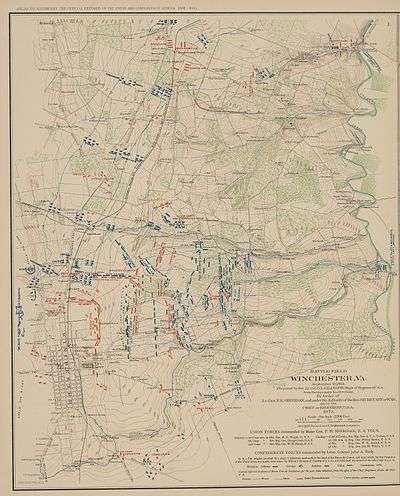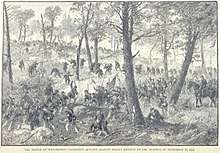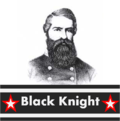Third Battle of Winchester
The Third Battle of Winchester (or Battle of Opequon), was fought just outside Winchester, Virginia, on September 19, 1864, during the Valley Campaigns of 1864 in the American Civil War.
After the victory at Berryville as the month began, Union Maj. Gen. Philip H. Sheridan sought information about the troop strength of Confederate Lt. Gen. Jubal A. Early. Earlier in the year, his subordinate Union Gen. George Crook had met Rebecca Wright, a Quaker schoolteacher and Union sympathizer in Winchester, a commercial center and transportation hub at the northern end of the Shenandoah Valley with many Confederate sympathizers and which changed hands 75 times during the war. Slave Thomas Laws of Millwood (between Berryville and Winchester) had a Confederate permit to sell produce in Winchester three days per week, and agreed to act as a Union spy. On September 16, Laws took Sheridan's letter (hidden in his mouth) to Wright, who consulted her mother and then replied (in a note which Laws also hid in his mouth) that a Confederate officer recovering from his wounds had recently bragged about Confederate artillery and infantry battalions under General Joseph B. Kershaw and Lt. Col. Wilfred E. Cutshaw having left Winchester to raid the B&O Railroad at Martinsburg, in the new state of West Virginia.[11][12]
Accordingly, Sheridan advanced toward Winchester along the Berryville Pike with the VI Corps and XIX Corps, crossing Opequon Creek. The Union advance was delayed long enough for Early to concentrate his forces to meet the main assault, which continued for several hours. Casualties were very heavy. The Confederate line was gradually driven back toward the town. Mid-afternoon, the Army of West Virginia and the cavalry turned the Confederate left flank. Early ordered a general retreat. Because of its size, intensity, serious casualties on both sides (particularly among the general officers) and its result (Confederates never again controlling Winchester and President Abraham Lincoln winning re-election), many historians consider this the most important conflict of the Shenandoah Valley.[13] Sheridan would later give much of the credit for the victory to "the brave Quaker girl", whose intelligence he thought worth a brigade of troops.[14]
Background
Military situation
Sheridan was given command of the Army of the Shenandoah and sent to the Shenandoah Valley to deal with Early's Confederate threat. For much of the early fall of 1864, Sheridan and Early had cautiously engaged in minor skirmishes while each side tested the other's strength. Early mistook this limited action to mean that Sheridan was afraid to fight, and he left his army spread out from Martinsburg to Winchester. Sheridan learned of Early's dispersed forces and immediately struck out after Winchester, the location of two previous major engagements during the war, both Confederate victories.
Opposing forces
Union
Confederate
Battle

Early quickly gathered his army back together at Winchester just in time to meet Sheridan's attack on September 19. The Union forces coming in from the east had to march on the narrow road through Berryville Canyon, which soon got clogged up with supply wagons and troops, delaying the attack. This delay allowed Early to further strengthen his lines. Maj. Gen. John B. Gordon's division arrived from the north and took up position on the Confederate left.
At 11:40 A.M., Sheridan attacked with Maj. Gen. Horatio G. Wright's Union VI Corps on the left flank astride the Berryville Turnpike and the XIX Corps, under Maj. Gen. William H. Emory, occupying the ground from Wright's right flank northward to Red Bud Run. The Sixth Corps was supported by well placed batteries but Emory had no artillery going into the battle due to the rugged and wooded nature of the terrain. After encountering heavy resistance from the Confederate divisions of Maj. Gen. Stephen D. Ramseur on the Berryville Pike and John B. Gordon's division (located in the Second Woods and Middle Field) in front of the XIX Corps, Sheridan succeeded in driving back the Confederates from their initial positions in confusion.
Although Sheridan's initial attack was successful, the terrain and road network combined with fierce Confederate artillery created a large gap in the center of the Union battle line. Fortuitously for Early, Maj. Gen. Robert Rodes division arrived on the battle field and counterattacked into this gap, forcing both the VI and XIX Corps to retreat. Ramseur and Gordon rallied their divisions and joined in the counterattack. Shortly after Rodes's troops advanced to the attack, he was struck by a shell fragment that mortally wounded him, robbing Early of his best subordinate general. His troops continued their attacking unaware of his fall. Sheridan, however, closed the breach by advancing the reserve divisions of the VI and XIX Corps. The VI Corps division of Brig. Gen. David Russell, who like Rodes, lost his life restoring the broken battle line, restored the broken line in the vicinity of the Berryville Pike to Ash Hollow in the center. In the northern sector of the battlefield, Brig. Gen William Dwight's division held the Union right flank after much bitter fighting against Gordon and elements of Rodes's command. At this time, approximately 2:00 P.M., a lull developed over the Berryville Pike sector of the battlefield, although Gordon kept up the pressure against Emory's XIX Corps in the Middle Field near Red Bud Run.
.png)
When the outcome of the 11:40 A.M. attack seemed in doubt, Sheridan sent the Army of West Virginia under Brig. Gen. George Crook to locate the Confederate left flank and look out for and protect the right flank of the XIX Corps. Sheridan also ordered Brig. Gen. James H. Wilson's cavalry division to advance toward Early's right flank and cut off his line of retreat from Winchester. Wilson started late and did not succeed in his mission in spite of the weak nature of the Confederates in his front. Sheridan rode to his right flank where he found the hard pressed XIX Corps and vociferously assured General Emory that Crook was coming up and that the Union forces would whip the rebels. Crook reached the Union right flank, he found Sheridan waiting for him and advanced into the First Woods toward the Middle Field where Dwight's division was still hanging on after taking heavy losses in its fight with Gordon. Crook decided to relieve the XIX Corps with Col. Joseph Thoburn's division and then personally led Col. Isaac Duval's division on a flank march north of Red Bud Run and attack Gordon's left flank.
Just before Crook's attack struck, Col. George Patton, grandfather of Gen. George Patton, and his brigade of Confederate infantry took position behind a stone wall along Hackwood Lane and covered Gordon's left flank and rear. Crook began the attack north of Red Bud Run and was soon joined by Thoburn's division. Although Duval's encountered a nearly impassable swamp, the men quickly detoured around the morass with some struggling through to continue the assault. At the same time, Thoburn's direct attack on Gordon combined with Duval's threatening presence caused the Confederate position to collapse. Patton found his brigade sandwiched between converging columns of Crook's infantry from the east and north and Col. Thomas Devin's Union cavalry brigade from the west. Patton was mortally wounded by a shell fragment during the withdrawal and his brigade was shattered, losing hundreds of men cut off and captured with every regimental battle flag being captured by the Union cavalry. Gordon rallied his men behind a stone wall that ran at right angles to his original position and checked Crook's continued advance.

When Crook attacked, Sheridan ordered the VI Corps to join the attack. Ramseurs' and Brig. Gen. Cullen Battle's (Rodes) divisions and Col. Tom Carter's southern artillery offered stout resistance to the VI Corps attack. Sheridan rode along its battle line, rallying and inspiring the troops as he moved toward the Berryville Pike. General Emory Upton (commanding Russell's division) was driving back Battle's left flank when a Confederate shell fragment knocked him out of the battle. The surgeon was able to stop the bleeding and Upton ordered a stretcher brought forward from which he watched the closing scenes of the battle while Col. Oliver Edwards led the division in the final advance on Winchester.
As the infantry pressed the stubborn Confederates back toward Winchester, Maj. Gen. Alfred Torbert's two divisions of cavalry charged down the Valley Pike shattering Early's left flank and getting behind his infantry. Early counterattacked with Brig. General Gabriel Wharton's two brigades of infantry, temporarily halting the horsemen. The division of Brig. Gen. Wesley Merritt regrouped and crushed the entrenched Confederate left while Crook's infantry hit Wharton and Gordon head on driving them back to the Smithfield Redoubt where they made another brief stand. At the same time, the division of Brig. Gen. William W. Averell charged up the western side of the Valley or Martinsburg Turnpike, driving back the remnants of Early's cavalry and capturing one piece of artillery. Averell continued his attack routing Confederate cavalry who attempted to rally at Star Fort and then pressing on toward Winchester. Col. Thomas Munford's Confederate brigade drove Averell's advance back on Fort Hill, buying enough time to allow thousands of Early's troops to avoid entrapment and capture before Colonel James Schoonmacher's brigade secured the heights. The Confederate army was in full retreat, "whirling through Winchester." As the Southern troops raced through Winchester in confusion, a number of ladies of the town including the wife of General Gordon joined arms and attempted to shame the men back to the battlefield, but the reality of the situation rendered their efforts fruitless. Sheridan had won the Third Battle of Winchester and U. S. forces held Winchester for the balance of the war and into Reconstruction.
Aftermath
The battle marked a turning point in the Shenandoah Valley in favor of the North. Early's army for the most part remained intact but suffered further defeats at Fisher's Hill and Tom's Brook. Exactly a month later, the Valley Campaigns came to a close after Early's defeat at the Battle of Cedar Creek. Victory in the Valley, along with other Union victories in the fall of 1864, helped win re-election for Abraham Lincoln, as Sheridan would later point out as a male attempted to oust Wright from her government job.[15]
The battle was particularly damaging due to the number of casualties among key commanders. In the Union army, Brig. Gen. David A. Russell was killed and Brig. Gens. Emory Upton, George H. Chapman, and John B. McIntosh were seriously wounded. Confederate Maj. Gen. Robert E. Rodes was killed and Maj. Gen. Fitzhugh Lee, Brig. Gens. William Terry, Archibald C. Godwin, and Col. William Wharton were wounded. Also among the Confederate dead was Col. George S. Patton, Sr. His grandson and namesake would become the famous U.S. general of World War II, George S. Patton, Jr.
Medals of Honor
During the battle, fourteen Union enlisted men and one officer received the Medal of Honor for their actions.
Battlefield preservation
Most of the preservation effort at the battlefield has been privately oriented. The Civil War Trust (a division of American Battlefield Trust) and its partners have acquired and preserved a total of 473 acres (1.91 km2) of the 567-acre battlefield.[16] One acquisition was made in 2009 by the Shenandoah Valley Battlefields Foundation, with participation by the Trust and the Virginia Land Conservation Foundation. At that time, these preservation groups purchased a 209-acre parcel known as the "Huntsberry Farm" tract, named for a family who lived on the land at the time of the battle, for $3.35 million.
The Shenandoah Valley Battlefields Foundation is presently engaged in restoring the battlefield, focusing first on the key battle area south of Redbud Run. Restoration and interpretation of this area is underway, focusing on the infamous 30-acre Middle Field, in time for the 150th Anniversary of the battle in September, 2014.
See also
Notes
- National Park Service.
- Further information: Official Records, Series I, Volume XLIII, Part 1, pages 107-112.
- Further information: Official Records, Series I, Volume XLIII, Part 1, pages 1002-1003.
- Further information: Official Records, Series I, Volume XLIII, Part 1, page 61.
- Salmon, p. 359; Eicher, p. 744, estimates 33,600 infantry, 6,400 cavalry; NPS, 39,240.
- Further information: Official Records, Series I, Volume XLIII, Part 1, page 1011.
- Eicher, p. 744, estimates 8,500 infantry, 2,900 cavalry; Salmon, p. 359, 12,500; NPS, 15,200.
- Further information: Official Records, Series I, Volume XLIII, Part 1, pages 112-119.
- Kennedy, pp. 315-16.
- Further information: Official Records, Series I, Volume XLIII, Part 1, page 557.
- https://www.hmdb.org/marker.asp?marker=46960
- Friends Intelligencer, Vol. 69, p. 389, available at https://books.google.com/books?id=Xpg6AQAAMAAJ&pg=PA389&lpg=PA389
- NPS.
- Noyalas, Jonathan A. ""That woman was worth a whole brigade"". HistoryNet (Originally published in the June 2012 issue of Civil War Times.). Retrieved 18 Nov 2019.
- http://www.historynet.com/woman-worth-whole-brigade.htm
- American Battlefield Trust "Saved Land" webpage. Accessed May 29, 2018.
References
- National Park Service battle description
- Eicher, David J. The Longest Night: A Military History of the Civil War. New York: Simon & Schuster, 2001. ISBN 0-684-84944-5.
- Kennedy, Frances H., ed. The Civil War Battlefield Guide. 2nd ed. Boston: Houghton Mifflin Co., 1998. ISBN 0-395-74012-6.
- Lewis, Thomas A., and the Editors of Time-Life Books. The Shenandoah in Flames: The Valley Campaign of 1864. Alexandria, VA: Time-Life Books, 1987. ISBN 0-8094-4784-3.
- Patchan, Scott C. The Last Battle of Winchester. Savas Beatie Press, 2013. ISBN 978-1932714982.
- Salmon, John S. The Official Virginia Civil War Battlefield Guide. Mechanicsburg, PA: Stackpole Books, 2001. ISBN 0-8117-2868-4.
- Woodworth, Steven E., and Kenneth J. Winkle. Oxford Atlas of the Civil War. New York: Oxford University Press, 2004. ISBN 0-19-522131-1.
Memoirs and primary sources
- Early, Jubal A. A Memoir of the Last Year of the War for Independence in the Confederate States of America. Edited by Gary W. Gallagher. Columbia: University of South Carolina Press, 2001. ISBN 1-57003-450-8.
- U.S. War Department, The War of the Rebellion: a Compilation of the Official Records of the Union and Confederate Armies. Washington, DC: U.S. Government Printing Office, 1880–1901.
Further reading
- Gallagher, Gary W., ed. The Shenandoah Valley Campaign of 1864. Military Campaigns of the Civil War. Chapel Hill: University of North Carolina Press, 2006. ISBN 978-0-8078-3005-5.
- Gallagher, Gary W., ed. Struggle for the Shenandoah: Essays on the 1864 Valley Campaign. Kent, OH: Kent State University Press, 1991. ISBN 0-87338-429-6.
- Patchan, Scott C. The Last Battle of Winchester: Phil Sheridan, Jubal Early, and the Shenandoah Valley Campaign, August 7–September 19, 1864. El Dorado Hills, CA: Savas Beatie, 2013. ISBN 978-1-932714-98-2.
- Wert, Jeffry D. From Winchester to Cedar Creek: The Shenandoah Campaign of 1864. New York: Simon & Schuster, 1987. ISBN 0-671-67806-X.
- Wittenberg, Eric J. Little Phil: A Reassessment of the Civil War Leadership of Gen. Philip H. Sheridan. Washington, DC: Potomac Books, 2002. ISBN 1-57488-548-0.
External links

- The Battle of Third Winchester: Maps, histories, photos, videos, and preservation news (Civil War Trust)
.jpg)
